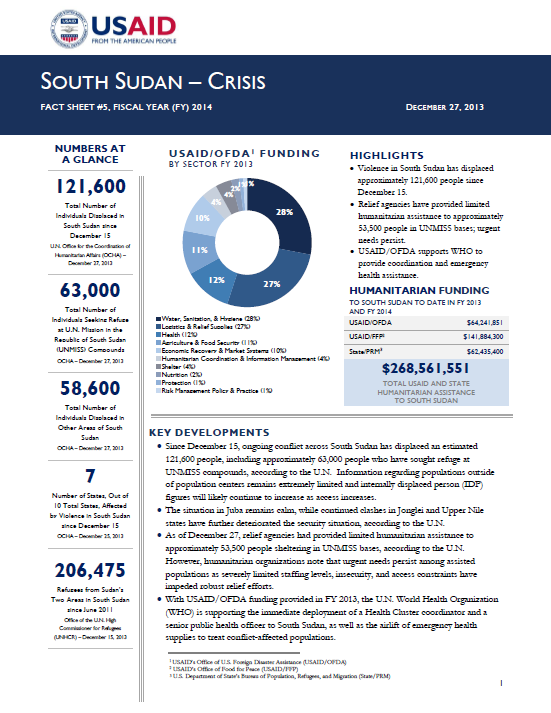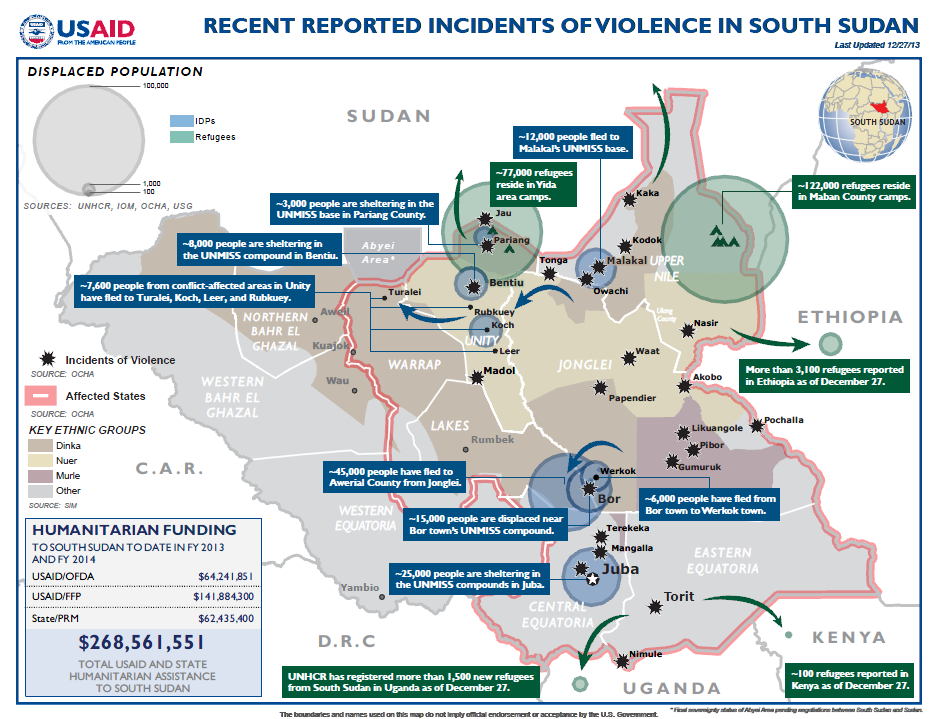- What We Do
- Agriculture and Food Security
- Democracy, Human Rights and Governance
- Economic Growth and Trade
- Education
- Environment and Global Climate Change
- Gender Equality and Women's Empowerment
- Global Health
- Humanitarian Assistance
- Transformation at USAID
- Water and Sanitation
- Working in Crises and Conflict
- U.S. Global Development Lab
Speeches Shim
May 30, 2014
Numbers At A Glance
1,040,706
95,000
945,706
375,500
237,700
Humanitarian Funding:
To South Sudan To Date In FY2014:
| USAID/OFDA | $110,000,000 |
| USAID/FFP | $147,400,000 |
| USAID/AFR | $14,200,000 |
| State/PRM | $73,300,000 |
| TOTAL | $344,900,000 |
Highlights
Nearly 900 cholera cases, including 27 deaths, reported in Juba since late April.
New UNMISS mandate makes civilian protection a priority.
Four donors commit 86 percent of the new $618 million in pledges announced at the humanitarian conference in Oslo, Norway.
KEY DEVELOPMENTS
The number of cholera cases in South Sudan continues to steadily increase, with nearly 900 cases, including 27 cholera-related deaths, reported in Juba, Central Equatoria State, since late April, according to the U.N. The Government of the Republic of South Sudan (RSS) Ministry of Health (MoH), relief agencies, and local actors continue to work to mitigate the spread of the outbreak and minimize cholera-related mortality.
The U.N. Security Council adopted a resolution to renew the UNMISS mandate on May 27. The new mandate allows the mission to adopt a more neutral position, focusing on the protection of civilians, human rights reporting, facilitation of the delivery of humanitarian assistance, and support for implementation of the cessation of hostilities agreement.
Donors pledged approximately $618 million for the crisis in South Sudan at the humanitarian conference in Oslo, Norway, on May 19 and 20, according to the U.N. Although the conference mobilized additional vital resources for the response, the total pledged will not cover the funding requested in the revised Crisis Response Plan (CRP) to save lives, prevent famine, and avert the loss of another generation of South Sudanese children. Less than half of the 48 countries in attendance pledged additional funding, with four donors—the U.S., the U.K., the European Union, and Norway—committing approximately 86 percent of the new pledges.
INSECURITY, DISPLACEMENT, AND ACCESS CONSTRAINTS
The current conflict has displaced more than 1.4 million people since December 15, including approximately 1 million internally displaced persons (IDPs) and 375,500 people who are seeking refuge in neighboring countries.
Insecurity remains a major challenge to providing assistance to populations in need. The U.N. reports continued tensions in Jonglei, Unity, and Upper Nile states, with clashes reported in Upper Nile’s Renk and Nasir counties in mid-May. U.N. sources report heavy military presence in northern Unity and fighting in Jonglei’s Akobo County. Tensions near Bentiu town, Unity, in mid-May, forced humanitarian agencies to temporarily suspend travel to the area, delaying the delivery of much-needed relief commodities.
Despite insecurity, relief agencies continue to press to reach affected populations in the most hard-to-reach areas. Humanitarian organizations, including the U.N. World Food Program (WFP) and the U.N. Food and Agriculture Organization (FAO), plan to scale up assistance to populations in remote locations in the coming weeks to prevent further deterioration of the food security situation.
South Sudan Crisis Fact Sheet #44 May 30, 2014 ![]() (pdf - 265k)
(pdf - 265k)
South Sudan Crisis Map, May 30, 2014 ![]() (pdf - 952k)
(pdf - 952k)
HUMANITARIAN NEEDS ASSESSMENTS AND RESPONSE ACTIVITIES
The U.N. Area Rapid Response Mechanism (ARRM)—led by the U.N. Children’s Fund (UNICEF), FAO, and WFP—continues to provide much-needed humanitarian assistance to vulnerable populations in remote locations. In late May, relief agencies began providing assistance—including food commodities, health care and nutrition services, and sanitation supplies—via the ARRM in Leer town, Unity, to approximately 36,000 conflict-affected people.
On May 14, relief actors conducted a rapid needs assessment in Ayod County, Jonglei, finding approximately 65,000 people in need of humanitarian assistance. On May 17, partners conducted a needs assessment in New Fangak town, Jonglei, identifying approximately 46,000 IDPs and 55,000 host community members in need of assistance. In response to the assessment findings, ARRM teams plan to provide health, nutrition, and water, sanitation, and hygiene (WASH) assistance to populations in Ayod and New Fangak in the coming weeks, according to the U.N.
In addition, local relief actors plan to conduct registration activities in Nasir, Upper Nile, following a May 20–21 assessment that found thousands of people in need of humanitarian support, according to the U.N.
CAMP COORDINATION AND CAMP MANAGEMENT
Efforts to improve living conditions for IDPs sheltering at UNMISS bases continue, despite challenges. The new protection of civilian (PoC) 3 area at U.N. House in Juba is nearing completion, according to the U.N. On May 28, the site was formally inaugurated with a handing over ceremony from the Embassy of the People’s Republic of China to UNMISS.
Meanwhile, the new PoC site in Malakal, Upper Nile, is also nearing completion. The U.N. reports that relocation from the existing PoC area to the new site will begin when force protection ensures security at the new site.
To better track and monitor data, IOM has begun incorporating biometric technology into the IDP registration process in South Sudan. IOM’s displacement tracking and monitoring unit used biometric technology during a recent household registration process in Juba’s Tomping and U.N. House PoC areas, gathering demographic statistics and tracking data related to IDP intentions regarding future movement. The data will help facilitate humanitarian assistance delivery and inform discussions regarding potential long-term displacement solutions.
AGRICULTURE, FOOD SECURITY, AND NUTRITION
Despite ongoing access and security constraints, WFP reached more than 1 million people—an increase of 76 percent from January—with food and nutrition assistance in April. In coordination with UNICEF, FAO, and non-governmental organization (NGO) partners through the ARRM, WFP plans to deploy multi-sector teams to Akobo and Mayendit County, Unity, to provide additional food and nutrition support in the coming month.
WFP-led registration activities and food commodity distributions are ongoing in Akobo, and WFP expects to deliver an estimated 1,700 metric tons (MT) of locally-purchased sorghum to conflict-affected populations in Maban and Melut counties, Upper Nile, in the coming weeks.
A portion of the approximately $618 million in humanitarian assistance pledged by donor countries during the May 19–20 pledging conference in Oslo will enable WFP to scale up food assistance and nutrition programming to reach 3.2 million vulnerable people in 2014.
HEALTH AND WASH
In coordination with the MoH, the Health and WASH clusters—the coordinating bodies for humanitarian health and WASH activities, respectively, comprising U.N. agencies, NGOs, and other stakeholders—continue response efforts to mitigate the ongoing cholera outbreak. As of May 29, health actors had reported nearly 900 cases of cholera in Juba, as well as 27 cholera-related deaths, since late April. An estimated 2 percent of the population in Juba—approximately 10,000 people—is expected to exhibit cholera symptoms during the outbreak based on the current rate of transmission, according to recent MoH and U.N. World Health Organization (WHO) reports.
The MoH continues to host multi-weekly national taskforce meetings focused on strengthening the cholera outbreak response through support for case management; surveillance and laboratory activities; social mobilization; and WASH support.
With $470,000 in USAID/OFDA funding through the RRF, Mercy Corps is continuing support for displaced populations at the Bentiu PoC site in Unity State. Responding to increased humanitarian needs following an influx of IDPs at the site due to fighting in and around Bentiu in late April, Mercy Corps will provide safe drinking water to IDPs, construct emergency latrines and bathing facilities, support solid waste collection and disposal, distribute WASH relief items, and support hygiene promotion activities.
With more than $145,000 in USAID/OFDA support through the IOM-managed Rapid Response Fund (RRF), local NGO Nile Hope is providing emergency health and nutrition services to conflict-affected populations in Akobo and Fangak counties, Jonglei State. The funding will help mobile health clinics reach populations in remote areas with health services, provide antenatal care and support safe deliveries, and provide emergency nutrition assistance to conflict-displaced children under five years of age.
Between December 15 and May 24, the Health Cluster reached nearly 1.2 million people in South Sudan with medical interventions, including life-saving vaccinations and surgeries for IDPs and host community members in Bor town, Jonglei, and Bentiu, Unity.
LOGISTICS AND RELIEF COMMODITIES
The Logistics Cluster airlifted more than 170 MT of humanitarian supplies for more than 17 relief partners to Akobo; Malakal; Jonglei’s Lankien, Old Fangak, and Walgak towns; and Unity’s Bentiu, Ganyiel, Leer, and Nyal towns during the week of May 19, WFP reports. In addition, the Logistics Cluster is working on a pipeline planning report to enable improved coordination of relief commodity storage and transportation across humanitarian partners in South Sudan, according to WFP.
In response to the ongoing rainy season and resultant access constraints via road and standard aircraft, the U.N. Humanitarian Air Service recently procured two additional aircraft suited for inclement weather to bolster humanitarian airlift capacity. As the rainy season continues, partners also plan to increase efforts to deliver food assistance via river from Juba to conflict-affected areas in northern South Sudan and from Gambella, Ethiopia, to Akobo.
OTHER HUMANITARIAN ASSISTANCE
Donors pledged an additional $618 million to address the crisis in South Sudan at the humanitarian conference in Oslo on May 19 and 20. While the additional funding brings the international community closer to meeting the $1.8 billion requested in the revised CRP, less than half of the 48 donors in attendance pledged new funding. Collectively, pledges from the U.S., the U.K., the European Union, and Norway represented approximately 86 percent of the total pledged, with the U.S. and the U.K. nearly doubling their contributions made prior to the conference.
On May 26, the Government of Estonia (GoE) pledged more than $272,000 in humanitarian assistance to South Sudan. GoE Foreign Minister Urmas Paet reported the new assistance will support various U.N. mechanisms and the International Committee of the Red Cross to deliver critical relief aid to the people of South Sudan.



Comment
Make a general inquiry or suggest an improvement.